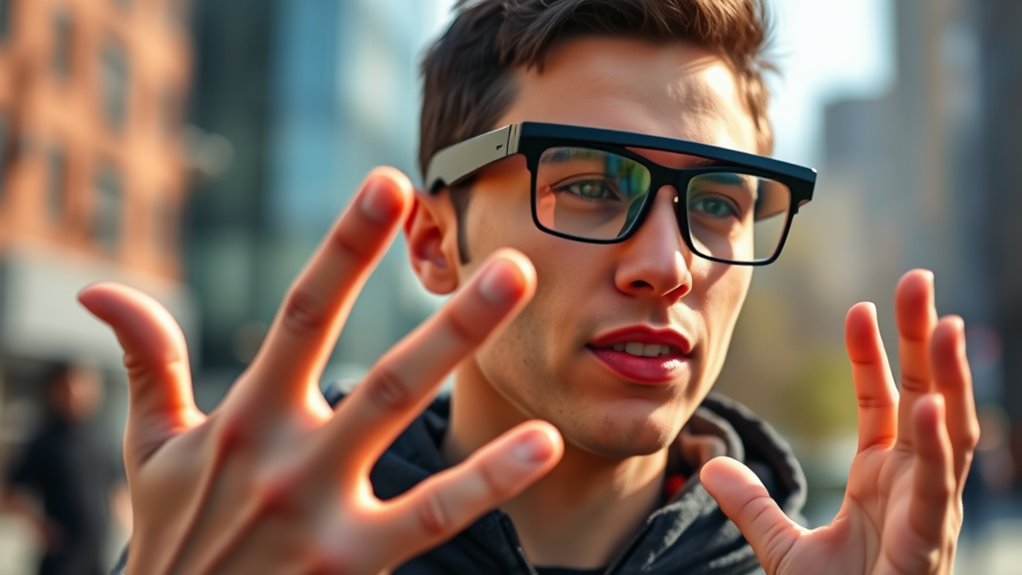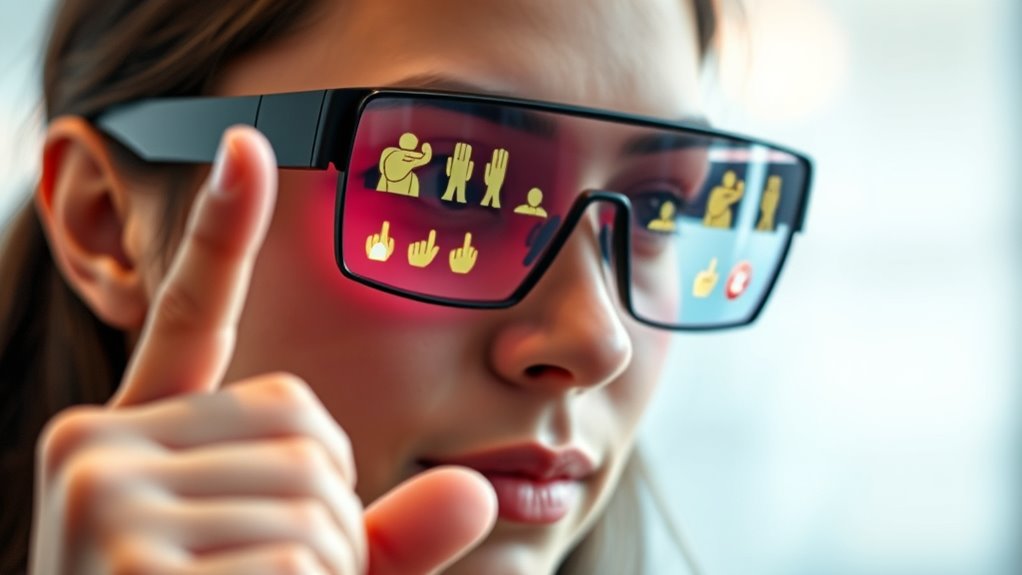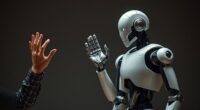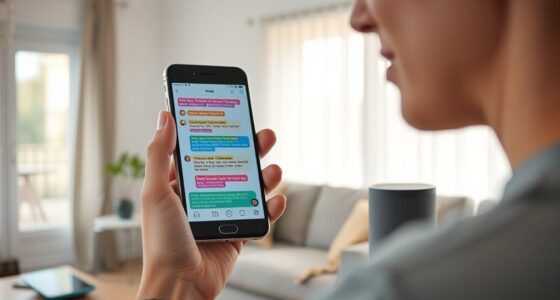Smart glasses with real-time gesture recognition use sensors, cameras, and machine learning to instantly translate sign language into spoken words or text. They continuously capture hand movements, analyze data with sophisticated algorithms, and project translations into your line of sight. This technology benefits deaf and hard-of-hearing communities by promoting easier communication and independence. If you’re curious about how these features work together, you’ll discover more about the innovative hardware and software driving this breakthrough.
Key Takeaways
- Smart glasses use sensors and cameras to detect hand gestures in real time for sign language translation.
- Machine learning algorithms compare captured gestures to sign language databases for accurate recognition.
- Real-time processing projects translations as text or speech directly into the user’s line of sight.
- Sensor calibration and data preprocessing ensure precise gesture detection and reduce recognition errors.
- These devices promote social inclusion by enabling seamless, instant sign language communication through smart eyewear.
The Technology Behind Gesture Recognition in Smart Glasses

The technology behind gesture recognition in smart glasses combines advanced sensors, machine learning algorithms, and real-time processing to interpret hand movements into meaningful commands. To guarantee accuracy, sensor calibration is essential; it fine-tunes the sensors to recognize gestures precisely and minimizes errors. Data preprocessing is the next critical step, where raw sensor data is cleaned and formatted, removing noise and irrelevant information. This prepares the data for effective analysis by the algorithms. As you wear the glasses, the sensors continuously capture your hand movements, and calibration ensures these signals are reliable. Proper preprocessing allows the system to interpret gestures quickly and accurately, enabling seamless interactions. This foundational technology makes real-time sign language recognition in smart glasses possible and reliable.
How Sign Language Is Translated in Real Time

As sensors in smart glasses continuously track hand movements, the system processes this data instantly to interpret sign language gestures. Achieving high gesture accuracy is essential, so algorithms analyze movement patterns against a vast database of signs. To enhance performance, the system adapts through user customization, learning individual signing styles over time. This personalization improves recognition rates and reduces errors. The translation process involves four key steps:
- Capturing precise hand and finger positions
- Comparing gestures to a predefined sign language database
- Adjusting recognition models based on user-specific input
- Rendering real-time translations into spoken words or text
This seamless process ensures swift, accurate communication, empowering users and bridging language gaps. Color accuracy plays a vital role in ensuring the system correctly interprets subtle hand movements, especially when distinguishing between similar signs.
Hardware Components Powering the Smart Glasses

Smart glasses rely on a sophisticated array of hardware components that work together to capture, process, and display sign language translations in real time. Sensor integration is key; tiny cameras and motion sensors track your hand gestures accurately. These sensors feed data into the processor, which analyzes movements quickly. Power management ensures the device runs efficiently, optimizing battery life without sacrificing performance. Compact batteries supply consistent energy, while smart power regulation prevents overheating and conserves energy during idle periods. The display components, such as transparent OLED screens, project the translated sign language seamlessly into your line of sight. Altogether, these hardware elements form a cohesive system that enables smooth, real-time gesture recognition, making the interaction natural and intuitive. Incorporating dog names can add a personalized touch to the device’s user interface, enhancing user engagement.
Software Algorithms and Machine Learning Applications

Software algorithms and machine learning applications form the backbone of smart glasses’ ability to interpret sign language accurately and in real time. You rely on large gesture datasets to train models, enabling precise recognition of hand movements. These datasets help improve algorithm accuracy through extensive variation and real-world examples. To enhance performance, algorithm optimization focuses on reducing latency and increasing efficiency. You might implement techniques like neural network pruning or quantization. Additionally, feature extraction algorithms identify critical movement patterns, streamlining data processing. Glycolic acid benefits for skin and the combination of robust datasets and optimized algorithms ensures your smart glasses deliver seamless, real-time sign language translation, bridging communication gaps effectively. This technological foundation is essential for creating intuitive, responsive gesture recognition systems you can trust.
Benefits for Deaf and Hard-of-Hearing Communities

Smart glasses can make communication more accessible for deaf and hard-of-hearing communities by translating sign language in real time. They also foster social inclusion by bridging gaps in understanding and interaction. Additionally, these devices support independence, allowing users to engage confidently in everyday activities.
Enhances Communication Accessibility
By providing real-time translation of sign language, smart glasses substantially improve communication for deaf and hard-of-hearing individuals. They enhance accessibility by bridging gaps where traditional methods fall short. With improved gesture accuracy, users can trust the device to interpret even subtle signs. The user interface is designed for intuitive interaction, allowing quick adjustments and seamless use. Additionally, smart glasses enable hydrocolloid technology to promote healing by drawing out impurities, which can be beneficial for users experiencing skin irritation from prolonged device wear. They also enable:
- Immediate understanding during conversations
- Reduced misinterpretations through precise gesture detection
- Hands-free operation for natural communication
- Customizable display settings for individual preferences
Together, these features make communication more accessible, empowering users to connect confidently in various environments. The combination of advanced gesture recognition and a user-friendly interface ensures that deaf and hard-of-hearing communities experience greater independence and social engagement.
Promotes Social Inclusion
When smart glasses provide real-time sign language translation, they open new opportunities for social inclusion among deaf and hard-of-hearing individuals. With gesture training, users can improve their sign language skills and communicate more effectively within diverse social settings. The device’s user customization features allow you to tailor the translation experience to your specific needs, making interactions more natural and comfortable. This technology bridges gaps in social participation, enabling you to engage confidently in conversations, community events, and everyday activities. By reducing communication barriers, smart glasses foster a sense of belonging and equal access, helping you connect with others without feeling isolated. Additionally, understanding anime movies and animated films can serve as a cultural bridge, enriching social interactions and shared interests. Ultimately, they promote a more inclusive society where everyone’s voice can be heard and understood.
Supports Independence
Smart glasses empower deaf and hard-of-hearing individuals to act more independently by providing immediate, on-the-spot sign language translation. This technology reduces reliance on others for communication, boosting confidence and self-reliance. However, privacy concerns arise, as continuous gesture recognition may expose sensitive conversations or personal data. Additionally, cultural implications must be considered, since some communities view sign language as more than just a communication tool—it’s a cultural identity. To navigate these issues, you should be mindful of:
- Ensuring data security to protect user privacy.
- Respecting cultural norms surrounding sign language use.
- Educating users about potential privacy risks.
- Balancing independence with community sensitivities.
- Understanding gesture recognition and its role in advancing accessible technology.
Future Developments and Potential Impact

As technology advances, future smart glasses are poised to revolutionize sign language communication by becoming more accurate, intuitive, and seamlessly integrated into daily life. Augmented reality will enhance user experience, overlaying translations directly onto your field of vision for effortless understanding. Wearable sensors will improve gesture recognition, capturing subtle movements with greater precision. These developments will enable real-time, hands-free communication, bridging gaps between sign language users and others. As AI continues to evolve, future smart glasses could personalize interactions, adapt to different sign languages, and even learn individual signing styles. Additionally, understanding the Ice Cream Terminology behind different gestures could further refine the accuracy of recognition systems. The potential impact is profound, fostering greater independence, inclusivity, and connection for deaf and hard-of-hearing communities worldwide. This technology promises to transform communication and break down barriers like never before.
Frequently Asked Questions
How Accurate Is the Gesture Recognition in Noisy Environments?
You might wonder about gesture recognition accuracy in noisy environments. Noise interference can disrupt sensors, reducing recognition accuracy, especially if gestures vary widely. However, advanced algorithms help filter out noise and adapt to gesture variability, improving reliability. While no system is perfect, these improvements mean you can expect fairly accurate gesture recognition even amid background noise, though some errors may still occur depending on the level of interference.
Can the System Recognize Multiple Sign Languages Worldwide?
You wonder if the system can recognize multiple sign languages worldwide. It’s designed for multilingual detection and cultural adaptation, so it can identify various sign languages with high accuracy. However, you should know that some nuances may still be challenging, especially with regional variations. Continuous updates improve its capabilities, but understanding specific cultural gestures remains essential for accurate recognition across diverse languages.
What Are the Privacy Implications of Real-Time Gesture Data Transmission?
You should consider the privacy implications of transmitting real-time gesture data, as it involves sensitive personal information. Ensure data encryption is in place to protect your gestures from unauthorized access. Additionally, your user consent is vital; you must be informed about how your data is used and shared. Without these safeguards, there’s a risk of privacy breaches, making it imperative to prioritize secure, transparent data practices.
How Long Does the Smart Glasses’ Battery Last During Continuous Use?
You wonder about the battery longevity of smart glasses during continuous use. Typically, the battery lasts between 4 to 8 hours, depending on power consumption and usage intensity. High-power features like gesture recognition and real-time processing drain the battery faster. To extend usage, you can disable non-essential features or carry a portable charger. Understanding power consumption helps you manage your device’s battery life more effectively during extended periods.
Are There Any Social or Cultural Barriers to Adopting This Technology?
Imagine a bridge connecting worlds—your adoption of this tech faces cultural acceptance and social integration hurdles. You might encounter skepticism if communities see it as intrusive or unfamiliar. Social norms and traditions could slow acceptance, making integration tricky. To succeed, you need to foster understanding and trust, showing that this technology enhances communication without replacing human connection. Overcoming these barriers requires patience and respect for diverse cultural perspectives.
Conclusion
Imagine a future where your smart glasses instantly bridge communication gaps for deaf and hard-of-hearing individuals. While some claim gesture recognition tech could replace human interpreters, it’s more about empowering connection and understanding. Though not perfect yet, this innovation reveals the incredible potential of technology to transform lives. Trust in the progress—because when barriers fall, genuine connection becomes possible, proving that tech’s true power lies in fostering human understanding.











